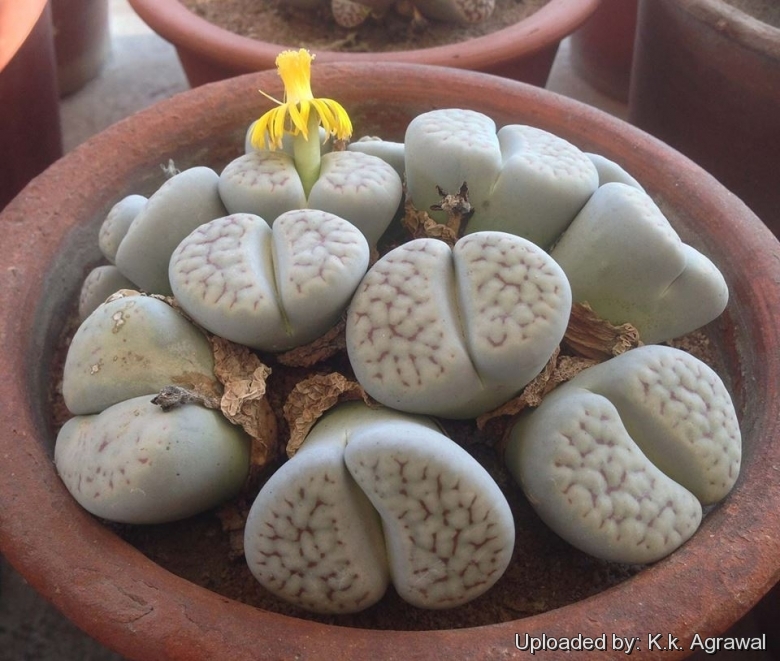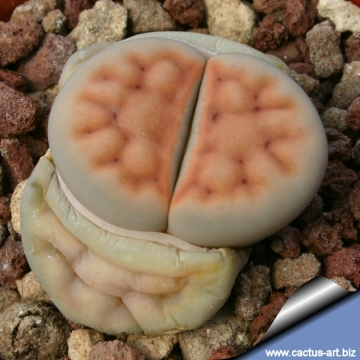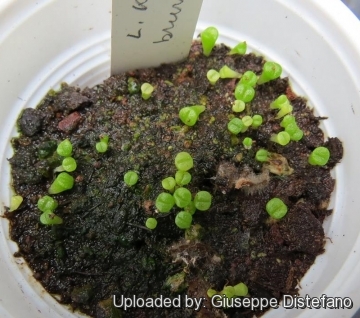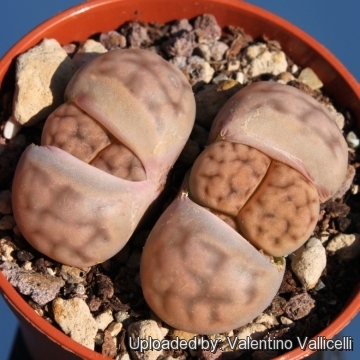Accepted Scientific Name: Lithops karasmontana N.E.Br.
Gard. Chron. 1926, Ser. III. lxxix. 102.

Mesembryanthemum karasmontanum (Lithops karasmontana) Photo by: K.k. Agrawal
Origin and Habitat: Namibia. It is sporadically distributed throughout the West and South West Great Karasberg, mainly in the Klein Karas, Grünau and and Ai-Ais.
Habitat: These fantastic stone or pebble plants grows in barren minerals plains and mountain slopes clinging to life in this harsh landscape. They live a precarious existence hidden beneath outcrops of quartz and Lichens. They grow almost completely buried in the ground with only the upper truncated portion of the thick, succulent leaves visible. Lithops karasmontanaSN|12138]]SN|12138]] resist attacks from herbivorous predators by mimicking the local stone formations, in this case quartzite, pegmatite, gneiss, calcrete, sandstone, and is almost impossible to distinguish from their surroundings until they erupt into vivid daisy-like white flowers. Colours of the background grey-white, white, grey, pink, yellow-brown, brown, reddish brown, greenish white. They grow along with some of the most fascinating succulent and xerophyte plants like Welwitschia mirabilisSN|22991]]SN|22991]] and quiver trees (Aloe dichotomaSN|616]]SN|616]]).
Synonyms:
See all synonyms of Lithops karasmontana
back
Accepted name in llifle Database:Lithops karasmontana N.E.Br.Gard. Chron. 1926, Ser. III. lxxix. 102.Synonymy: 41
- Lithops karasmontana N.E.Br.
- Lithops damarana (N.E.Br.) N.E.Br.
- Lithops karasmontana var. aiaisensis (de Boer) D.T.Cole
- Lithops karasmontana var. aiaisensis C224 TL: 110 km W of Karasburg, Namibia
- Lithops karasmontana var. aiaisensis C409 30 km E of Ai-Ais, Namibia
- Lithops karasmontana C065 (Signalberg Form) 25 km WNW of Grünau, Namibia
- Lithops karasmontana C168 (syn. mickbergensis) 10 km NNE of Grünau, Namibia
- Lithops karasmontana C169 (syn. mickbergensis) 20 km NNE of Grünau, Namibia
- Lithops karasmontana C223 25 km NE of Grünau, Namibia
- Lithops karasmontana C225 30 km NW of Grünau, Namibia
- Lithops karasmontana C226 25 km W of Grünau, Namibia
- Lithops karasmontana C227 (syn. jacobseniana) TL: 10 km SW of Grünau, Namibia
- Lithops karasmontana C317 (syn. mickbergensis) 15 km NE of Grünau, Namibia
- Lithops karasmontana C327 (syn. mickbergensis) 15 km NNE of Grünau, Namibia
- Lithops karasmontana C328 (Signalberg Form) 25 km WNW of Grünau, Namibia
- Lithops karasmontana C408 40 km NE of Ai-Ais, Namibia
- Lithops karasmontana var. lateritia (Dinter) hort., nov. comb. ined.
- Lithops karasmontana var. lericheana (Dinter & Schwantes) D.T.Cole
- Lithops karasmontana var. lericheana C193 50 km NNE of Grünau, Namibia
- Lithops karasmontana var. lericheana C267 TL: 70 km N of Karasburg, Namibia
- Lithops karasmontana var. lericheana C329 70 km N of Karasburg, Namibia
- Lithops karasmontana var. lericheana C330 70 km N of Karasburg, Namibia
- Lithops karasmontana var. mickbergensis (Dinter) de Boer & Boom
- Lithops karasmontana var. opalina (Dinter) de Boer & Boom
- Lithops karasmontana var. summitatum (Dinter) de Boer
- Lithops karasmontana var. tischeri D.T.Cole
- Lithops karasmontana var. tischeri C182 TL: 30 km NNE of Grünau, Namibia
Accepted name in llifle Database:Lithops karasmontana subs. bella (N.E.Br.) D.T.ColeLithops Flowering Stones 217 (1988)Synonymy: 7
Accepted name in llifle Database:Lithops karasmontana subs. eberlanzii (Dinter & Schwantes) D.T.ColeLithops Flowering Stones 219 (1988)Synonymy: 19
- Lithops karasmontana subs. eberlanzii (Dinter & Schwantes) D.T.Cole
- Lithops edithae N.E.Br. non Schwantes
- Lithops erniana Tischer ex H.Jacobsen
- Lithops erniana var. witputzensis de Boer
- Lithops karasmontana subs. eberlanzii C082 35 km E of Lüderitz, Namibia
- Lithops karasmontana subs. eberlanzii C147 (syn. erniana) 40 km S of Aus, Namibia
- Lithops karasmontana subs. eberlanzii C149 (syn. erniana witputzensis) TL: 110 km SSE of Aus, Namibia
- Lithops karasmontana subs. eberlanzii C208 10 km S of Aus, Namibia
- Lithops karasmontana subs. eberlanzii C209 (syn. erniana) 10 km SSE of Aus, Namibia
- Lithops karasmontana subs. eberlanzii C369 TL: 20 km E of Lüderitz, Namibia
- Lithops karasmontana subs. eberlanzii C370 35 km 35 km E of Lüderitz, Namibia
- Lithops karasmontana subs. eberlanzii C398 45 km E of Lüderitz, Namibia
- Lithops karasmontana subs. eberlanzii C399 45 km E of Lüderitz, Namibia
- Lithops karasmontana subs. eberlanzii C400 45 km E of Lüderitz, Namibia
- Lithops karasmontana subs. eberlanzii C401 25 km SE of Lüderitz, Namibia
- Lithops karasmontana subs. eberlanzii C404 50 km E of Lüderitz, Namibia
Cultivars
(8):
back
Description: Lithops karasmontanaSN|12138]]SN|12138]] (a.k.a. Stone plant) is a tiny perennial, caespitose, succulent plant resembling a grouping of tiny pebbles split down the middle like cleft hooves. It grows to a maximum eight of 4 cm above ground and spreads to form small clumps with up to 12 or more heads (usually 2-6). It is one of the more variable species, with uniformly coloured or variously ornamented plants, and yet with opaque or obscurely windowed forms; there is also a great variation in the colours. Plants from different localities show strikingly different colours or patterns, but all natural populations show some degree of variation among individuals, and in some all possible intermediates colours and pattens occur.
Stem: Almost stemless.
Bodies (Paired leaves): Inverted cone-like, divided into 2 unequal-sized, conjunct and coalescent leaves. These leaves are modified for water storage as well as photosynthesis. Face elliptic-reniform 25-35 x 20-28 mm broad usually rugose. Top flat to slightly convex, fissure fairly deep, 4-10 mm long. Colours pale grey or bluish-grey on lower parts and shoulders, upper surfaces mottled with, brick red, beige, yellow, grey-green, brown, pale purple-brown, pink, grey-white on the flat sunken surfaces, rubrications absent or a network of dots, hooks, triangles, short lines, no lip-smear. Windows obscurely translucent greyish, bluish or brownish often absent. Margins indistinct or with more or less evident indentations, light grey tinged with various shades of blue, green, yellow, brown, pink or red. Channels narrow and irregular greyish, bluish, brownish green, or red-brown often limited to slightly impressed obscure lines and obscurely translucent. Often the channel are completely covered with dark brown, red or purplish rubrications that forms short lines, hooks, triangles and dots linked into a network. Islands irregular in shape, frequently only vaguely noticeable. Dusky dots absent or very inconspicuous.
The plant renews itself every year or so by putting out a new plantlet from between the two lobes. Once the new plant is full sized, the old lobes shrivel up and slough off as a snake skin does.
Flowers: Big up to 4,5 cm in diameter (mostly 25-35 mm) satiny white, narrow-rayed.
Blooming season: Late summer or early autumn.
Fruit: Seed capsules mostly 5-chambered, otherwise 4 or 6-chambered. Profile boat-shaped.
Seeds: Minuscule, yellow-brown; smooth to rugose.
Subspecies, varieties, forms and cultivars of plants belonging to the Lithops karasmontana group
 Lithops karasmontana N.E.Br.: is uniformly coloured or variously ornamented. Plants from different localities show strikingly different colours or patterns. Distribution: Namibia. West and South West Great Karasberg, mainly in the Klein Karas, Grünau and and Ai-Ais.
Lithops karasmontana N.E.Br.: is uniformly coloured or variously ornamented. Plants from different localities show strikingly different colours or patterns. Distribution: Namibia. West and South West Great Karasberg, mainly in the Klein Karas, Grünau and and Ai-Ais. Lithops karasmontana var. aiaisensis (de Boer) D.T.Cole: has pale grey to brownish bodies, with darker grey to reddish-brown branched branched wrinkles, window usually absent. Distribution: Ai-Ais in Namibia.
Lithops karasmontana var. aiaisensis (de Boer) D.T.Cole: has pale grey to brownish bodies, with darker grey to reddish-brown branched branched wrinkles, window usually absent. Distribution: Ai-Ais in Namibia. Lithops karasmontana var. aiaisensis C224 TL: 110 km W of Karasburg, Namibia: pale stone grey.
Lithops karasmontana var. aiaisensis C224 TL: 110 km W of Karasburg, Namibia: pale stone grey.- Lithops karasmontana var. aiaisensis C409 30 km E of Ai-Ais, Namibia
 Lithops karasmontana var. aiaisensis cv. Orange top: reddish-orange tops.
Lithops karasmontana var. aiaisensis cv. Orange top: reddish-orange tops. Lithops karasmontana var. aiaisensis cv. Red Blushed Selection: (Mesa Garden 1625.3) Distinctive pale pastel top mottled orange-grey to reddish-orange. They are quite variable, no two plants look exactly the same.
Lithops karasmontana var. aiaisensis cv. Red Blushed Selection: (Mesa Garden 1625.3) Distinctive pale pastel top mottled orange-grey to reddish-orange. They are quite variable, no two plants look exactly the same. Lithops karasmontana subs. bella (N.E.Br.) D.T.Cole
Lithops karasmontana subs. bella (N.E.Br.) D.T.Cole- Lithops karasmontana subs. bella C108 TL: 5 km S of Aus, Namibia: jagged milky windows.
 Lithops karasmontana subs. bella C143A 60 km NNE of Aus, Namibia: striking zebraic pattern.
Lithops karasmontana subs. bella C143A 60 km NNE of Aus, Namibia: striking zebraic pattern. Lithops karasmontana subs. bella C285 Near Aus, Namibia: light grey, large windows.
Lithops karasmontana subs. bella C285 Near Aus, Namibia: light grey, large windows. Lithops karasmontana subs. bella C295 115 km SSE of Aus, Namibia: very wide jagged windows.
Lithops karasmontana subs. bella C295 115 km SSE of Aus, Namibia: very wide jagged windows. Lithops karasmontana C065 (Signalberg Form) 25 km WNW of Grünau, Namibia: red dots and lines, coarse.
Lithops karasmontana C065 (Signalberg Form) 25 km WNW of Grünau, Namibia: red dots and lines, coarse. Lithops karasmontana C168 (syn. mickbergensis) 10 km NNE of Grünau, Namibia: orange grey, variable.
Lithops karasmontana C168 (syn. mickbergensis) 10 km NNE of Grünau, Namibia: orange grey, variable. Lithops karasmontana C169 (syn. mickbergensis) 20 km NNE of Grünau, Namibia: orange grey.
Lithops karasmontana C169 (syn. mickbergensis) 20 km NNE of Grünau, Namibia: orange grey.- Lithops karasmontana C223 25 km NE of Grünau, Namibia: grey indented lines.
 Lithops karasmontana C225 30 km NW of Grünau, Namibia: grey green top, deep lines.
Lithops karasmontana C225 30 km NW of Grünau, Namibia: grey green top, deep lines. Lithops karasmontana C226 25 km W of Grünau, Namibia: stone grey body, red-green dots.
Lithops karasmontana C226 25 km W of Grünau, Namibia: stone grey body, red-green dots. Lithops karasmontana C227 (syn. jacobseniana) TL: 10 km SW of Grünau, Namibia: orange grey body.
Lithops karasmontana C227 (syn. jacobseniana) TL: 10 km SW of Grünau, Namibia: orange grey body. Lithops karasmontana C317 (syn. mickbergensis) 15 km NE of Grünau, Namibia: extremely varied.
Lithops karasmontana C317 (syn. mickbergensis) 15 km NE of Grünau, Namibia: extremely varied. Lithops karasmontana C327 (syn. mickbergensis) 15 km NNE of Grünau, Namibia: rough orange rocks.
Lithops karasmontana C327 (syn. mickbergensis) 15 km NNE of Grünau, Namibia: rough orange rocks.- Lithops karasmontana C328 (Signalberg Form) 25 km WNW of Grünau, Namibia: blurred red marks.
- Lithops karasmontana C408 40 km NE of Ai-Ais, Namibia
 Lithops karasmontana subs. eberlanzii (Dinter & Schwantes) D.T.Cole
Lithops karasmontana subs. eberlanzii (Dinter & Schwantes) D.T.Cole Lithops karasmontana subs. eberlanzii C082 35 km E of Lüderitz, Namibia: milky brown, mottled lines.
Lithops karasmontana subs. eberlanzii C082 35 km E of Lüderitz, Namibia: milky brown, mottled lines.- Lithops karasmontana subs. eberlanzii C147 (syn. erniana) 40 km S of Aus, Namibia: pink grey.
 Lithops karasmontana subs. eberlanzii C149 (syn. erniana witputzensis) TL: 110 km SSE of Aus, Namibia: light grey.
Lithops karasmontana subs. eberlanzii C149 (syn. erniana witputzensis) TL: 110 km SSE of Aus, Namibia: light grey. Lithops karasmontana subs. eberlanzii C208 10 km S of Aus, Namibia: brown-red lines.
Lithops karasmontana subs. eberlanzii C208 10 km S of Aus, Namibia: brown-red lines.- Lithops karasmontana subs. eberlanzii C209 (syn. erniana) 10 km SSE of Aus, Namibia: chicken foot scratches.
- Lithops karasmontana subs. eberlanzii C369 TL: 20 km E of Lüderitz, Namibia: pale or well-lined.
 Lithops karasmontana subs. eberlanzii C370 35 km 35 km E of Lüderitz, Namibia: decorator colors.
Lithops karasmontana subs. eberlanzii C370 35 km 35 km E of Lüderitz, Namibia: decorator colors.- Lithops karasmontana subs. eberlanzii C370A TL: 35 km E of Lüderitz, Namibia cv. Avocado Cream D.T.Cole: yellow green when ripe.
- Lithops karasmontana subs. eberlanzii C398 45 km E of Lüderitz, Namibia
- Lithops karasmontana subs. eberlanzii C399 45 km E of Lüderitz, Namibia
- Lithops karasmontana subs. eberlanzii C400 45 km E of Lüderitz, Namibia
- Lithops karasmontana subs. eberlanzii C401 25 km SE of Lüderitz, Namibia
- Lithops karasmontana subs. eberlanzii C402 40 km E of Lüderitz, Namibia cv. Avocado Cream
- Lithops karasmontana subs. eberlanzii C404 50 km E of Lüderitz, Namibia
- Lithops karasmontana subs. eberlanzii cv. Purper
 Lithops karasmontana var. lateritia (Dinter) hort., nov. comb. ined.: sensu Dinter!, bright rusty red top.
Lithops karasmontana var. lateritia (Dinter) hort., nov. comb. ined.: sensu Dinter!, bright rusty red top.- Lithops karasmontana var. lericheana (Dinter & Schwantes) D.T.Cole
 Lithops karasmontana var. lericheana C193 50 km NNE of Grünau, Namibia: light orange grey.
Lithops karasmontana var. lericheana C193 50 km NNE of Grünau, Namibia: light orange grey. Lithops karasmontana var. lericheana C267 TL: 70 km N of Karasburg, Namibia: dark jagged pattern.
Lithops karasmontana var. lericheana C267 TL: 70 km N of Karasburg, Namibia: dark jagged pattern. Lithops karasmontana var. lericheana C329 70 km N of Karasburg, Namibia: bold red humps.
Lithops karasmontana var. lericheana C329 70 km N of Karasburg, Namibia: bold red humps. Lithops karasmontana var. lericheana C330 70 km N of Karasburg, Namibia: mottled orange-grey.
Lithops karasmontana var. lericheana C330 70 km N of Karasburg, Namibia: mottled orange-grey.- Lithops karasmontana var. mickbergensis (Dinter) de Boer & Boom
 Lithops karasmontana var. mickbergensis cv. 99.44% white: pale selected form with a distinctive near white to clear pinkish top,some pink-orange.
Lithops karasmontana var. mickbergensis cv. 99.44% white: pale selected form with a distinctive near white to clear pinkish top,some pink-orange. Lithops karasmontana var. opalina (Dinter) de Boer & Boom
Lithops karasmontana var. opalina (Dinter) de Boer & Boom Lithops karasmontana var. summitatum (Dinter) de Boer
Lithops karasmontana var. summitatum (Dinter) de Boer- Lithops karasmontana var. summitatum cv. Red Selection
 Lithops karasmontana var. tischeri D.T.Cole
Lithops karasmontana var. tischeri D.T.Cole Lithops karasmontana var. tischeri C182 TL: 30 km NNE of Grünau, Namibia: rusty, deep lines.
Lithops karasmontana var. tischeri C182 TL: 30 km NNE of Grünau, Namibia: rusty, deep lines.- Lithops karasmontana cv. Top Red
Notes: Lithops are partly subterranean, with only the clear 'window' in each leaf tip exposed above soil. A type of optical system exists whereby a layer of apical tissue rich in calcium oxalate crystals acts as a filter to intense sunlight before it reaches the thin chlorophyllous layer below. They are also called mimicry plants as they show a striking similarity to their background rocks and are difficult to detect when not in flower. These are the commonly known as pebble plants or living stones; each species is associated with one particular type of rock formation and occurs nowhere else. Its soil-embedded, subterranean growth form also reduces the need for chemical defences against herbivores.
Bibliography: Major references and further lectures
1) Gert Cornelis Nel, “Lithops: Plantae Succulente, Rarissimae, in Terra Obsuratae, E Familia Aizoaceae, Ex Africa Australi” Hortors Limited, University Press, Stellenbosch. 1946
2) Linda R. Berg “Introductory Botany: Plants, People, and the Environment” Cengage Learning, 02/Mar/2007
3) Dieter J. Von Willert “Life strategies of succulents in deserts: with special reference to the Namib desert” CUP Archive, 1992
4) Chris Mcintyre “Namibia” Bradt Travel Guides, 2007
5) Neale (W. T.) & Co, Edgar Lamb “Neale's photographic reference plates, 1949: Combining cacti and other succulents” Vol. 2 W. T. Neale & Co.
6) RHS “A-Z encyclopedia of garden plants.” United Kingdom: Dorling Kindersley. 2008
7) American Horticultural Society “The American Horticultural Society encyclopedia of garden plants” Macmillan, 30/Nov/1989
8) H. E. K. Hartmann “Illustrated Handbook of Succulent Plants: Aizoaceae F-Z” Springer, 2002
9) Schwantes, Gustav. “Flowering Stones and Mid-day Flowers” London: Ernst Benn. 1957
10) S. M Walters “The European Garden Flora Flowering Plants: Casuarinaceae to Aristolochiaceae” Cambridge University Press, 1989
11) Clive Innes “Complete Handbook of Cacti and Succulents” Van Nostrand Reinhold Company, 01/Dec/1981
12) Cole, D. T. “Flowering stones” Acorn Books, Randburg. 1988
13) Smith et al. “Mesembs of the World.” Briza.Pretoria 1998
14) Leistner, O.A. (ed.), “Seed plants of southern Africa: families and genera” Strelitzia 10., National Botanical Institute, Pretoria 2000
15) Achim Hecktheuer “Mesembs, mehr als nur Lithops” Books on Demand GmbH Norderstedt. 2008
16) Cole “LITHOPS Flowering Stones” Cactus & Co. Libri. 2005
17) Yasuhiko Shimada “The Genus Lithops” Dobun Shoin. 2001
18) Rudolf Heine “Lithops - Lebende Steine” Neumann Verlag. 1986
19) Bernd Schlösser “Lithops – Lebende Steine” Praktische Anleitung für die Zimmerkultur. BussinessPoint MEDIA. 2000
20) Steven A. Hammer “Lithops – Treasures of the veld” British Cactus and Succulent Society. 1999
21) David L. Sprechman “Lithops” Associated University Presses, Inc. 1970
 - (SB2166 Onverwacht) This species shows various pale pastel shades. (Lithops karasmontana) Photo by: Cactus Art
- (SB2166 Onverwacht) This species shows various pale pastel shades. (Lithops karasmontana) Photo by: Cactus Art Mesembryanthemum karasmontanum (Lithops karasmontana) Photo by: Giuseppe Distefano
Mesembryanthemum karasmontanum (Lithops karasmontana) Photo by: Giuseppe Distefano (SB2166 Onverwacht) A plant at the end of the dry winter rest. (Lithops karasmontana) Photo by: Valentino Vallicelli
(SB2166 Onverwacht) A plant at the end of the dry winter rest. (Lithops karasmontana) Photo by: Valentino Vallicelli Klein Karas, often reddish-orange. (MG 1623.8) (Lithops karasmontana) Photo by: Valentino Vallicelli
Klein Karas, often reddish-orange. (MG 1623.8) (Lithops karasmontana) Photo by: Valentino VallicelliCultivation and Propagation: Lithops need an open mineral, fast draining mix and the maximum amount of light you are able to give them. The basic cultivation routine is: Stop watering after flowering. Start watering after the old leaves completely dry. (Usually late March or Early April) Water freely during the growing season, soak the compost fully but allow it to dry out between waterings. Some growers fertilize frequently, some hardly ever. Keep them dry during the winter. Nearly all problems occur as a result of overwatering and poor ventilation especially when weather conditions are dull and cool or very humid.
Propagation: From seed, with seed planting best in either October or April.














